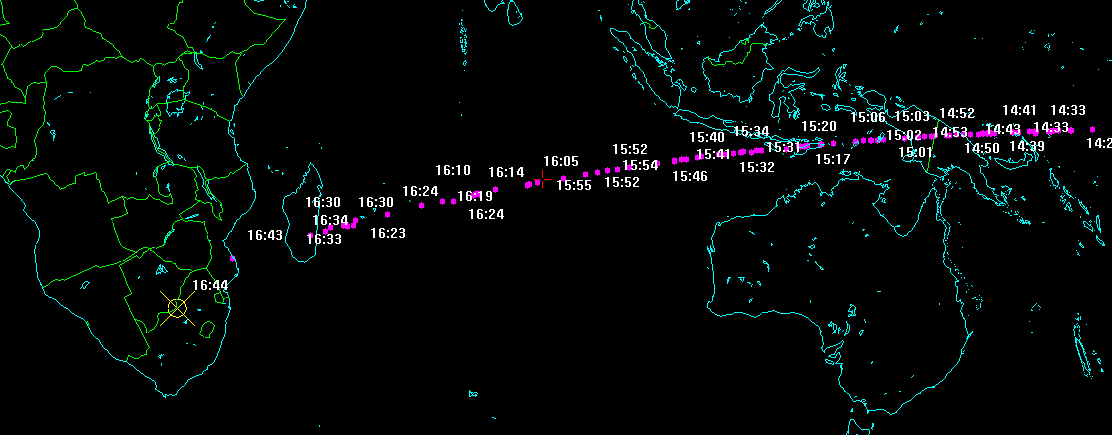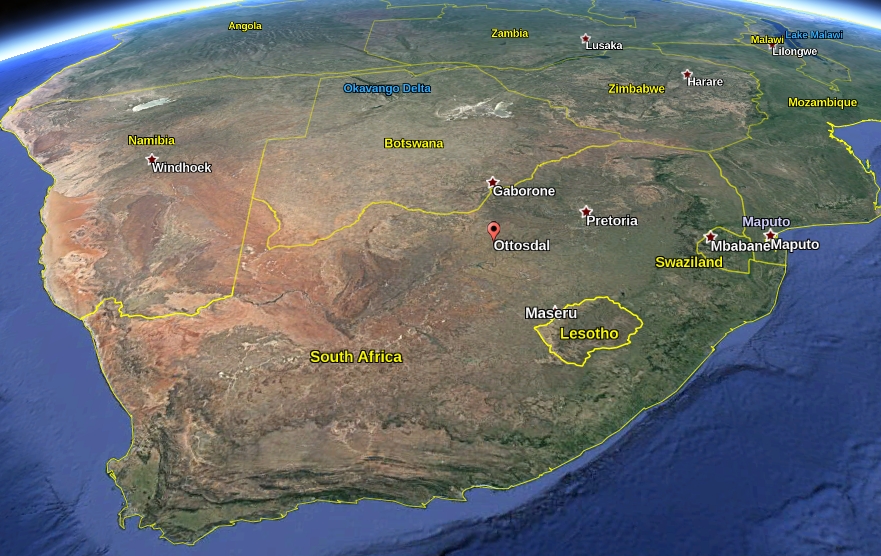Asteroid 2018 LA explodes over South Africa and Botswana several hours after discovery

A newly discovered asteroid designated 2018 LA exploded somewhere along the South Africa – Botswana border region at 16:53 UTC on June 2, 2018. The asteroid was discovered several hours before it entered our atmosphere. It is possible pieces of it survived the entry and hit Earth. This is only the third time that an asteroid has been discovered to be on an impact trajectory.
This Apollo-class asteroid had an estimated diameter between 2.1 and 4.6 m (6.8 and 15 feet). It was first observed at Mt. Lemmon Survey (Catalina Sky Survey, Arizona) at 09:32 UTC, just over 7 hours before it entered our atmosphere at a speed (relative to the Earth) of 16.97 km/s.
As reported earlier today, the explosion was captured on a security camera owned by Barend Swanepoel from Ottosdal, South Africa:
Another witness from South Africa said the object was showing a yellow color as it was flying through the atmosphere. The yellow color suggests 2018 LA contained sodium, the same as 2013 Chelyabinsk asteroid.
The difference between these two objects is mainly their size. Chelyabinsk asteroid had a diameter of about 20 m (65 feet) and it exploded over a populated area, damaging over 3 000 buildings and injuring over 1 500 people (mostly by broken window glass).
[ Ephemeris | Orbit Diagram | Orbital Elements | Mission Design | Physical Parameters | Close-Approach Data ]
When it was discovered, asteroid 2018 LA had a temporary label ZLAF9B2.

Estimated trajectory of ZLAF9B2 (2018 LA) by ProjectPluto.com (MPML and Peter Birtwhistle)

Swanepoel's camera location near Ottosdal, South Africa. Credit: Google
Alex Gibbs, the principal engineer at the Catalina Sky Survey, posted these images of the object on his Facebook page:
Peter Brown, a meteor scientist and planetary astronomer at the University of Western Ontario, confirmed the impact earlier today.
"A strong infrasound of a bolide was detected over Botswana between 14:45 and 17:00 UTC on June 2," he said. "The yield was between 0.3 and 0.5 kT, corresponding to 2 m (6.5 feet) diameter asteroid."
Strong infrasound detection of a bolide at station I47 in South Africa today at 1730 UT. Origin time between 1645-17 UT over Botswana. Yield 0.3-0.5 kT, corresponding to 2m diameter asteroid. #fireball #neoimpacts pic.twitter.com/fVe5GtwTtb
— Peter Brown (@pgbrown) June 3, 2018
"It remains to be seen if any pieces made it to the ground," Gibbs said after Brown posted infrasound data.
According to eNCA, two large meteors were spotted around the North West province on June 2. One meteorite fell between Lichtenburg and Mafikeng, and the one in the video posted by Barend Swanepoel fell between Hartebeesfontein and Coligny.
Interestingly, this event took place just one day after a similar bright fireball exploded over the Chinese city of Jinghong in Yunnan Province:
"The discovery of asteroid 2018 LA is only the third time that an asteroid has been discovered to be on an impact trajectory," said Paul Chodas, manager of the Center for Near-Earth Object Studies (CNEOS) at JPL. "It is also only the second time that the high probability of an impact was predicted well ahead of the event itself."
The first event of this kind was the impact of asteroid 2008 TC3, which lit up the predawn sky above Northern Sudan on October 7, 2008. That was a slightly larger asteroid (about 4 m / 13 feet in size), and it was discovered a full 19 hours before impact, allowing for a large number of follow-up observations and a very precise trajectory to be calculated.
The second predicted impact event was for asteroid 2014 AA, which was discovered only a few hours before impact on January 1, 2014, in the Atlantic Ocean, leaving too little time for follow-up observations.
The Catalina Sky Survey has been responsible for discovering all three of these small asteroids on impact trajectories, and all on the watch of the same observer, Richard Kowalski.
Reference:
Asteroid 2018 LA at Minor Planet Center; at CNEOS
Featured image: The green line indicates the object's apparent motion relative to the Earth, and the bright green marks are the object's location at approximately one-hour intervals. The blue arrow points in the direction of Earth's motion and the yellow arrow points toward the Sun. Credit: Minor Planet Center.

Commenting rules and guidelines
We value the thoughts and opinions of our readers and welcome healthy discussions on our website. In order to maintain a respectful and positive community, we ask that all commenters follow these rules.